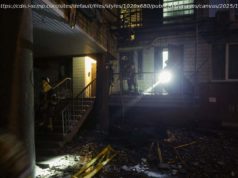Journalist Richard Pyle, whose long and accomplished Associated Press career spanned the globe and a half-century of crisis, war, catastrophe and indelible moments in news reporting, died at age 83.
NEW YORK (AP) — Journalist Richard Pyle, whose long and accomplished Associated Press career spanned the globe and a half-century of crisis, war, catastrophe and indelible moments in news reporting, died at age 83.
He died Thursday at a hospital of respiratory failure due to lung fibrosis and obstructive lung disease, said his wife, actress-writer Brenda Smiley.
Pyle was there when President John F. Kennedy learned of the Cuban missile challenge and when President Richard Nixon waved goodbye to the White House, when the World Trade Center ’s twin towers came down and when a Pennsylvania nuclear plant almost blew up, when the last Americans walked out of Hanoi’s war prisons and when Desert Storm drove the last Iraqis from Kuwait.
Pyle was even there at age 75, dashing to the shoreline when Capt. Chesley B. Sullenberger’s jetliner made its lifesaving splash-landing in the Hudson River in 2009, the year Pyle retired after 49 years with the AP.
In the end, Pyle was proudest of his Vietnam War coverage over five critical years, the last half as chief of the news organization’s Pulitzer Prize-winning Saigon bureau.
A journalist in the 1960s “couldn’t let this story go by,” he said. “It was the greatest story I’ve ever had.”
AP’s executive editor, Sally Buzbee, on Thursday praised Pyle for the depth of his journalism.
“ Richard Pyle never lost his passion for great stories and never lost his insistence on strong, probing journalism,” Buzbee said. “Years after he had retired, he buttonholed me at an event, wanting to know: ‘Were we committed to the journalism? Were we keeping AP focused on strong reporting? Were we screwing it up?’ It’s people like Pyle who are the conscience of a news organization like The Associated Press.”
Former AP President Lou Boccardi described him as “a man for all seasons.”
“His career took him to distant places but we knew he would be at home anywhere,” Boccardi wrote. “He was an extraordinary guy who took pride in being an AP newsman and he made all of us better.”
Richard H. Pyle was 10 years old in 1944 when he reported the D-Day invasion of France, papering the walls of his suburban Detroit home with bulletins gleaned from the radio. By his college days he knew his calling. After two years in the Army, he was graduated in journalism from Wayne State University in Detroit.
He first worked on a suburban newspaper, and then he joined the AP’s Detroit bureau in 1960. In October 1962, he was covering Kennedy in Michigan when the president broke off his visit and flew back to Washington as the Cuban missile crisis unfolded.
After stints at international editing desks in New York and Washington, he volunteered in 1968 to cover the conflict in Vietnam, where the gregarious, goateed Midwesterner joined an AP staff of stars, including writer Peter Arnett and photographers Horst Faas and Nick Ut, all Pulitzer winners.
The combat death of one colleague in 1971 would particularly weigh on Pyle, by then bureau chief responsible for an entire staff. The AP’s talented Henri Huet and three other photographers were killed when a South Vietnamese army helicopter was shot down in a remote area of Laos. Their remains were beyond retrieval, but Pyle vowed to get there someday.
More than 20 years later he received a call from the Pentagon’s missing-in-action search teams, seeking information, and by 1998 a team was headed to the crash site, accompanied by Pyle and former Saigon photo chief Faas. They later described the mission in a book, “Lost over Laos.” No identifiable remains were found, but recovered shards of bone were interred at the Newseum, Washington’s journalism museum.
After a final big story, flying to Hanoi for release of the last American prisoners of war, Pyle plunged into a new assignment in Washington in 1973, beating all others in reporting the resignation of disgraced Vice President Spiro Agnew. He went on to cover the post-Watergate presidential transition from Nixon to Gerald Ford, while also being sent to report news beyond the Beltway, including Middle East wars and the Three Mile Island nuclear plant disaster.
Walter Mears, a former AP vice president, Washington bureau chief and national political writer who collaborated with Pyle on the Agnew exclusive, called him “a solid AP guy.”
“He was a very good reporter who stuck with the story once he got a whiff of it,” Mears said.
In the 1980s, first as Asia news editor in Tokyo and then as a roving Mideast correspondent, Pyle covered scores of headline stories, from revolution in the Philippines to war in Lebanon and the Iran-Iraq conflict.
Back home in 1990, he joined the AP’s New York bureau. But the Pyle byline still ranged far afield: He reported on such New York stories as mob boss John Gotti’s 1992 trial and the 2001 terror attack on the World Trade Center as well as the 1991 Gulf War and the 1999 Kosovo conflict.
Pyle also was the author of the 1991 book “Schwarzkopf,” on America’s Gulf War commander Norman Schwarzkopf, and co-author of “Breaking News: How the Associated Press Has Covered War, Peace, and Everything Else,” a 2007 history of the AP, a fit subject for someone who never tired of extolling the virtues of the news cooperative, whose reach he sensed with his first AP byline.
Reporting on a bid for a post office by a Michigan town named Hell, Pyle wrote a witty piece full of wordplay on the town’s name. Hours later his editor showed him a message from across the sea: “Detroit, your Hell, Michigan, getting smash play front pages London.”
“Jesus Christ,” he recalled thinking. “Does this happen every day?”
He was hooked and ready for a long run.






